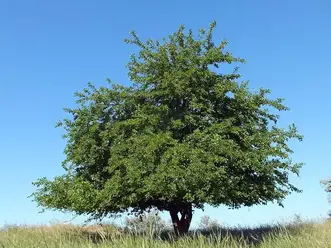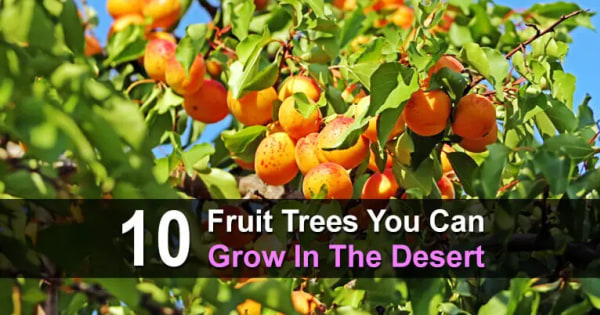Survival
Sign Up & Get Your FREE Homesteading Book!
SEND IT
HOMESTEAD SURVIVAL SITE
YOU ARE HERE: HOME / GARDENING / THE ONE TREE THAT EVERY HOMESTEADER SHOULD PLANT
Want to Start a Homestead but Not Sure How?
Sign Up and Get Your FREE Book, "How To Homestead No Matter Where You Live."SEND IT
We won't send you spam. Unsubscribe at any time.
The One Tree That Every Homesteader Should Plant
By Kristina Phelan 18 CommentsThis post may contain affiliate links.* As an Amazon Associate I earn from qualifying purchases. Click here to read our affiliate policy.
11k
SHARES

Estimated reading time: 5 minutes

Trees are a homesteader’s best friend. They provide shelter from the sun, wind, and rain, as well as protection from intruders. They often have medicinal properties or produce food—or both. Firewood is yet another benefit, and it’s essential for homesteaders who are off the grid.
Most homesteaders who purchase a property find themselves wishing that the previous owners had planted more trees. But as the Chinese proverb says, “The best time to plant a tree was 20 years ago. The second best time is now.”
Article continues below.
While there are plenty of options when it comes to trees you can plant, it’s important to note what your end goal is. An orchard of apple trees would be great for providing fruit year after year, while a line of evergreens would be beneficial as a windbreak. Cedar trees provide beautiful wood that can be used to build, while maples provide an excellent amount of shade for both the yard and the home.
It was hard for me to narrow down the one tree that every homesteader should plant. However, if you only had the resources to purchase or pick one tree, we think the mulberry tree would be the best one. While some believe that this is a rather messy tree, I believe its benefits outweigh the negative.
Want to save this post for later? Click Here to Pin It On Pinterest!
Here’s why we chose the mulberry tree as the tree that every homesteader should plant:
Mulberry Trees Grow Quickly
A vital component of choosing the best tree involves the amount of time it takes the tree to grow. While there are plenty of beautiful and majestic trees, many are slow-growing, which significantly diminishes their value in the short term. Mulberry trees, however, can grow up to 10 feet each year, making them an excellent choice.Want to start a homestead but not sure how?
Click Here to get a FREE book, "How To Homestead No Matter Where You Live."

Take advantage of this quick-growing tree to use along the property lines of the homestead. Not only will the trees look lovely, but they will grow quickly enough that they can help add a hedge of protection to the home from the wind, snow, rain, and even other people. You can help expand your mulberry trees using cuttings from one tree to create many different trees.
When growing trees to use as wood fuel, mulberry trees often produce more wood per acre than most other trees, thanks to their quick growth rate. The wood is often used as firewood but could also come in handy for other small projects. The berries are also quick to appear on a young tree, adding to their ability to be useful sooner rather than later.
However, it is important to note that mulberry trees are often regarded as invasive or overbearing thanks to their growth rate. Make sure to plant a mulberry tree far away from the home and permanent structures as their root systems can cause havoc on foundations. The key to using mulberries on the homestead is to plant them far away from anything else for the best experience.
Mulberry Trees Produce Fruit
Gathering food sources is the primary job of any homesteader. You not only grow a garden but also raise animals to provide either dairy or meat for the family. This was why it was important for us to choose a tree that also offered some sort of edible.Mulberries are great to eat straight off the tree and are often used as a substitute for blackberries and raspberries. You can use them in a variety of recipes and even make delicious mulberry wine as well. One of the best parts of the mulberry tree is that you can also use the stem, leaves, and bark to create edible items.
Mulberries taste somewhat like grapefruit and are often used to create jams and jellies that are so valuable on the homestead.
Mulberries Provide Health Benefits
Keeping your family safe from disease and injury is another essential part of living on the homestead. Mulberries were used in ancient Chinese medicine to help treat diabetes, arthritis, and even heart disease.Many use mulberries to help improve digestive systems as well. They can help with constipation thanks to their fiber content. Mulberries have also proven their ability to help lose weight.
Mulberries are also believed to reduce the risk of cancer thanks to their high level of antioxidants. They also help control blood pressure and assist in overall blood circulation. They are also rich in iron, making them an important food source for those who struggle with anemia.
Want to start a homestead but not sure how?
Click Here to get a FREE book, "How To Homestead No Matter Where You Live."
Mulberries Used in Textiles
While you can find a wide variety of mulberry trees that bear white, blue, and black mulberries, most homesteaders will find their mulberries ripen to a deep red color in late May or early June. This dark-colored fruit often stains the hands of those picking the berries, as well as any light-colored surface located underneath the tree.You can use the dark color of the berries to dye fabric or textiles on the homestead when you’ve had your fill of the fruit. A little bit of juice from these dark berries goes a long way in staining fabric to use all around the homestead.
While you may regret not planting trees every year, you’ll seldom regret planting trees on the farm. Different varieties of trees offer a wide range of benefits, but we think the mulberry tree is the one option that will give you the most bang for your buck. When choosing just one tree to plant this year, consider the mulberry tree for its multiple uses and delicious fruit.
Like this post? Don’t Forget to Pin It On Pinterest!
You May Also Like:
- 10 Trees That Bear Fruit Fast
- 10 Trees Every Homesteader Should Plant (And Why)
- 3 Reasons To Store Wheat Berries Instead of Flour
- How to Plant a Fruit Tree
- 7 Mistakes to Avoid when Harvesting Rain Water
11k
SHARES
Want to Start a Homestead but Not Sure How?
Sign Up and Get Your FREE Book, "How To Homestead No Matter Where You Live."SEND IT
We won't send you spam. Unsubscribe at any time.
You May Also Like:

How to Plant a Tree on Your Homestead

How to Plant a Fruit Tree

10 Fruit Trees You Can Grow In The Desert
Explore Homestead Survival Site

7 Gardening Tips from Native Americans

How to Make Castile Soap (The Most Gentle Soap!)

How To Make Homemade Neosporin
Comments
- Mike Kiernan says
JULY 16, 2020 AT 11:24 AM
Hello Kristina, Thanks for the suggestion but mulberry trees are not hardy; they can’t take the winters. Regards, Mike Kiernan West Fargo, North Dakota
REPLY- Ema says
JULY 17, 2020 AT 2:20 PM
Mine are volunteer, not from a nursery and are tough to kill. Our winters can get below 0, and have winds to boot, yet every one has managed to survive. Berries make a good cobbler, and the leaves are great animal fodder, my cattle loved them, and I guess goats would probably much them too. Do a google search on mulberry leaves for livestock food, pretty interesting, though mostly used in foreign countries.
REPLY
- Ema says
- Susan says
JULY 18, 2020 AT 8:56 AM
birds love the mulberries that grow on the trees. This is a huge problem that you did not mention. Bird droppings from eating the fruit. Yep! Purple bird droppings everywhere. Hopefully you do not hang laundry outside because the purple will stain. If you leave your car out they hit your car, your sidewalk, your house. The birds love these berries. We pulled our mullberry trees out!!!! Planted apples instead. We live in northern Michigan where they grow in abundance.
REPLY - Sandy says
FEBRUARY 8, 2021 AT 9:40 PM
I Get volunteer mulberry trees every year. They come up in the blackberries row. I do love the shade they make but wish I didn’t have to dig up every year. Also we make trellis from the branches that grow long and straight.
REPLY - Uncle Doug says
FEBRUARY 13, 2021 AT 1:52 PM
Every one attempting to survive comfortable should take a tour of your surroundings and discover what fruits, nuts, mushrooms, berries are growing good in your area. that is what u take cuttings from and using “root grow” start a root system and grow them Im in Idaho at 4500 feet so elderberry plant will produce 100 pounds of great fruit. Plant a bunch, Currents , huckleberries in your shaded areas, blackberries
raspberries, blue berries are hardy, Apples grow wild here so plant a bunch A LARGE greenhouse is a must. You can gather used windows free all over the place , frame them in as u get them. dig your greenhouse 4 feet into the earth and run 4-6 inch pipes hundreds of feet any where u can get them below frost line, i went 5 feet WONDERFUL HEATERS. in 1975 i put a 5 dollar large computer fan on both ends of a 200 foot long buried one pushed -other pulled and it heats well and has been running until now every time the sun hits the small solar panel. You cannot fight Nature, you must work with it to be able to live in comfort. In a hard winter i only use 3=4 cords of wood and never have a fire going 24 hrs. just early in the morn and its good all day. Its a wonderful life, truly in harmony with our planet
Allow me to give you some info on buying your land. Dealing with permits just doesnt work with homesteading. that is what your getting away from. You need 40 acres, here’ s why,
40 acres is deemed Agricultural, NO PERMITS required to build Agriculture structures, So DO NOT build a HOME, you are building a Farm Management Unit. – no permit- Dont build a GARAGE, build a “Machinery Storage SHed” – no permits. Get it. Dealing with idiots is just not in the picture. Here is another tidbit. a No Tresspassing Sign is worth less. as it is not a command . So u post D O NOT TRESSPASS, 1000 fine.
Now you the owner has issued a direct command and a consequence for violation the command. Get It.
More later, i ve got to get going now. Good Luck, its a great life, Some day ill write up some good sense rules for all to follow. A Fabulous book you should be able to find an download free is “the Have More Plan” here is the free download site https://archive.org/details/TheHaveMorePlan
Good Luck God Bless b e Happy in the Journey
its worth every bit of the work u put in the quest
doug
REPLY- Big Tee says
OCTOBER 2, 2021 AT 2:55 PM
Many thanks.
REPLY - Jami 7086740913 says
AUGUST 17, 2022 AT 12:13 PM
Wow highly impressed with everything you just shared I would love to get in touch and learn more from you
REPLY
- Big Tee says
- Big Tee says
OCTOBER 2, 2021 AT 2:54 PM
I was just reading about Air Layering mulberries. Check it out. Turn one tree into many.
REPLY - Regina Roark says
OCTOBER 30, 2021 AT 5:52 AM
Curious, as your postings are filled with such valuable information about self-sufficiency, do you have a book available as well. I rather like to purchase books so information is captured when the grid goes.
Thank you for all you do!
REPLY - Sheila says
MAY 8, 2022 AT 8:40 PM
I have battled mulberry trees in my chain link fences for years. I have quite feeding the birds in summer as they drop so many mulberry seeds in the yard. Their root systems are quite tenacious and extremely difficult to dig up. We just bought two acres in Missouri, and we’ll plant many trees, but not mulberries!
REPLY - Cindy says
AUGUST 6, 2022 AT 10:06 AM
Those that are expressing their dislike of Mulberry trees are missing the main point that Kristina Phelan made about how best to enjoy all of the many benefits of this awesome tree… the key is to have it at a good distant from your home, vehicles, and underground plumbing. We have multiple properties, the smallest being 1/4 acre lot, the largest being 40 acres. The Mulberry trees on the smaller properties are at the back edge where they cause no negative effects at all. On the larger properties we just make sure to transplant (or give away) the ones that pop up in areas where we don’t want them. We eat the berries fresh, make preserves, jelly, syrup and baked goods. Our livestock enjoy the leaves and branches as part of their diet, we dry the leaves for medicinal use, and fresh leaves/stems/bark/roots are used for medicinal tinctures. Wouldn’t want to be without them!
REPLY - Kate says
AUGUST 17, 2022 AT 12:05 PM
Mulberry trees are great producers for fruit and fodder no doubt, but in zones of 5 and below they will grow like weeds. I live in northern NH and they aren’t so prolific there but my daughter has an acre and a half in the south shore area of Mass and they are everywhere, shading over everything and rooting out everything.
I remember my father fighting them on his land in the St. Louis metro area when I was a kid.
If you plant one, be aware that they will spread with bird droppings, root spreading and even the stumps will propagate like wild shrubs if not destroyed. Just like many plants and trees, awareness is the answer and a plan or the readiness to deal with its care and quirks is essential.
REPLY- Henry Storer says
APRIL 7, 2023 AT 9:41 PM
So when you say zones 5 and below you mean they don’t grow well in Zones 6 and up? I ask for clarification because you state they are not prolific where you live in northern New Hampshire where growing zones are 1-5 yet you state the grow like weeds in zones 5 and below. Zones 5 and below would be zones 1, 2, 3, 4, & 5 would it not?
REPLY
- Henry Storer says
- Ethel N. says
FEBRUARY 13, 2023 AT 8:33 AM
I went to a big box store years ago and bought a tree that said River birch. When it started making berries. I knew it wasn’t what the tag said. After researching it, I found out I had bought a Mulberry tree! It is in my front yard. A couple of years ago I had a volunteer come up in the back so I moved it way in the back. They do grow really fast. I make jams and jellies with what I can reach and the birds enjoy the rest. I am in S.W. Georgia.
REPLY - Basil and Janine Barr says
APRIL 17, 2023 AT 6:59 AM
My wife and I are pensioners and look towards all plants that will provide a sustaining food source such as vegetables or trees that provide something meaningful.
I have found avocado trees at the top of my list as they are seen as a super food.
They bear fairly quickly if a grafted tree is planted.
Excess fruit is marketable and fetch a reasonable price.
We have a cottage on a small property so don’t have countless options.
Best regards
REPLY - Maddie Garcia says
APRIL 17, 2023 AT 1:40 PM
I have one growing on the side of my house next to my foundation. I didn’t know they were that invasive. I will have to cut it down now so that it will not affect the foundation of the house. The only thing is that the birds love them and eat the berries. Now I can see why my driveway is always stained…from the bird poop.
REPLY - RedRaspberry says
MAY 2, 2023 AT 7:15 AM
Mulberries are one of my biggest weed trees here in Central Illinois. I use to dig in the early spring but now just clip them off and paint the remaining trunk with some Stump Stop. I let a patch grow out away from everything.
REPLY - sherwin says
MAY 18, 2023 AT 2:50 PM
if you have limited space then you can always grow apple, cherry, pears, peach, fig, apricot, orange and lemon trees in large pots and buckets.
REPLY
Leave a Reply
Your email address will not be published. Required fields are marked *Comment *
Name *
Email *
 report this ad
report this ad report this ad
report this adTOP POSTS
 report this ad
report this ad© Copyright 2017-2021 Homestead Survival Site · All Rights Reserved
Disclosure · Privacy · Terms of Use · Contact · Direct Ad Sales · Site Map
Facebook · Pinterest · Twitter
* Homestead Survival Site is a participant in the Amazon Services LLC Associates Program, an affiliate advertising program designed to provide a means for us to earn fees by linking to Amazon.com and affiliated sites.
COPYRIGHT © 2023 · AGENCY PRO ON GENESIS FRAMEWORK · WORDPRESS · LOG IN





